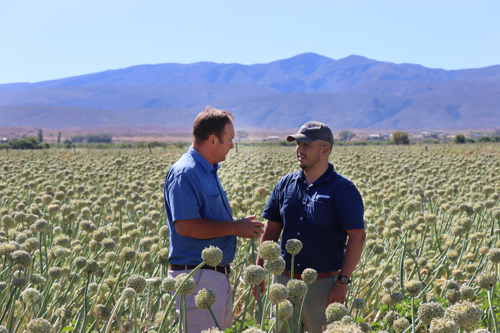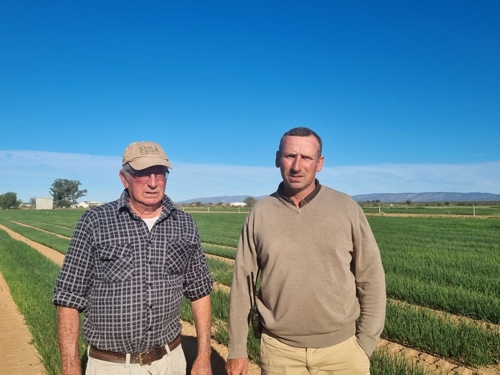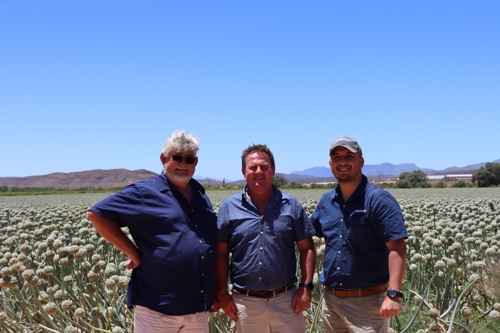Tough thin wall triumphs for Klein Karoo seed farmers
Drip irrigation and seed production have a long history. Pressure compensated heavy wall driplines were traditionally used given the fact that onion seed, for example, must be moved every year and not all fields have the same topographies. In the early 2000s, farmers typically used 3.5 litre per hour drippers with 60 cm spacing. The typical flow rate was later reduced to 2.3 litre per hour.
As the industry learned more about drip irrigation, soil types and the crops in question, they realised that closer dripper spacings make it possible to irrigate with greater efficiency. It also reduces over irrigation and leaching of fertilizers. The traditional pressure compensated drip was too expensive to justify closer spacings. In addition, the use of long-term drip in combination with poor water quality creates issues with clogging over time. The installation, recoiling, moving and storage of heavy wall drip are furthermore very labour intensive and often a big challenge.
Various industry role-players, including Netafim, started working with producers to do trials in seed producing areas. These trials investigated the possibility of using non-pressure compensated drip, thinner wall driplines, lower flow rates and closer spacing. It was a very successful investigation and the start of a shift towards a new irrigation approach in the seed production industry.
“We switched to thin wall drip with 30 cm spacing and a lower flow rate of 1 litre per hour about a decade ago. The biggest reason behind this decision was our aim to achieve more uniform yields,” says Louis Zaayman of Zaayman Boerdery near Calitzdorp. According to Zaayman, this approach allows better control of fertilizer and water delivery. This in turn leads to greater uniformity and higher yields.
According to Zaayman the industry has made great strides in the last 10 years. “You may have been laughed at 10 years ago if you predicted current yields, but today much higher yields are a reality. This can be attributed to the improvement of several management practices around nutrition, pollination, water management and more. The shift to lower flow rate drippers and closer spacing was definitely one of the factors that played a big role.”
John Fullard of Farm Acres 4 Boerdery near Barrydale has been using thin wall driplines with 1 litre per hour flow rates and 30 cm spacing for the past 8 to 10 years. He reminds us that your yield is only as good as your plant stand and irrigation. “Irrigation plays a massive role in success, so it is crucial that I install driplines that can do the job. It is a large annual investment, but when I know the drip irrigation equipment and my irrigation approach are right and ready, the investment is worthwhile.”
Fullard emphasizes that the increased control made possible by this irrigation approach, allows you to manage the root zone optimally. “This is especially important as we work with poor quality water. The root zone must be leached from salts and therefore the goal is to keep the root zone continuously wet so that salts can be pushed out to the edge of the root zone.”
“Most importantly, I must have irrigation equipment that can do the job at hand, and I must be able to trust this equipment to work optimally throughout the season.”
Louis Zaayman of Zaayman Boerdery and Byron la Trobe of Netafim SA in an onion seed field.

Long-term or short-term
Long-term heavy wall drip comes with a labour intensive installing and recoiling process. Furthermore, drippers can clog over time and affect the uniformity of water delivery.
“My water quality is just too poor to use long-term drip. It makes a lot more sense to use short-term thin wall drip that not only allows me to use new drip every year but is also easier to install and remove. It makes more sense financially and is more suitable to the type of farming we do.”
Zaayman adds that thin wall drip coils are just so much easier to work with. “I can easily load a bunch of coils in the bakkie and take it to the team in the field. They have a stand to put the coils on and then they simply walk through the field to roll off the drip. We also don’t have to reconnect pieces of pipe, as is the case with heavy wall drip. This reduces the risk of non-uniform delivery. With thin wall drip, risk of damage during the installation process is however higher, but if you invest in quality driplines this challenge is easily overcome.”
“For a long time, I used heavy wall driplines for irrigation in seed production,” says Andre Fourie of JLA Boerdery near Calitzdorp. “When the drought came, however, the water quality became so bad that it made more sense to switch to short-term drip irrigation where I can start each season fresh with new drippers and accurate water delivery. I even save time and labour as the installation and removal processes are so much easier.”
All benefits usually come with disadvantages and in the case of thin wall drip it is the fact that used drip piles up on farms and plastic is used at a high rate. “For us, the biggest challenge with thin wall drip is the massive amounts of plastic waste created. A recycling solution is crucial. Luckily, Netafim is working with us to find a solution and the company has already started with beta tests for a recycling solution in our area. I see it as a benefit if recycled pipe can be used in making new pipe, as is done by Netafim in other countries. I will be willing to pay more for a product if I know that there is a recycling solution in place,” says Zaayman.
Johan Fourie and Andre Fourie of JLA Boerdery.

Local dripline production
At the start of 2023, Netafim South Africa delivered the first locally produced roll of the stalwart thin wall dripline, Streamline™ X. Streamline™ X is an extremely tough thin wall dripline and has been available in the market for some time. Local production however means that the dripline can now be offered at a more competitive price. This has given many Klein Karoo seed farmers the opportunity to use the dripline on their farms for the first time.
“We decided to switch all of our seed production irrigation to Streamline™ X at once,” says Zaayman. “We definitely don’t regret this decision. Our first experience with Streamline™ X was very positive and we will definitely continue using it.”
Zaayman shared that they had no blockages during the past season. This is in comparison to previous years when blockages occurred often. “This is the most important factor for me as it affects uniform delivery and therefore uniform yield.”
Fullard adds that burst pipes and leakages occurred significantly less than in previous years. “All the other thin wall products I have used, have always had bursts during the season. This year there were significantly fewer occurrences of burst pipes, and we didn’t have to use as many connectors.
According to Fourie, leakages that occur during installation and generally working with the pipe also occurred less than in previous years. “Except for one or two spots where mice got to the pipe, I had no leakages. After the first season I can confirm that this is the best of all the thin wall products I have used.” Fourie says he chose Streamline™ X as its technical information showed that it can handle higher pressures. “My experience confirmed that it truly can handle higher pressures in practice.”
Fullard concluded that the biggest benefit of using Netafim products is the support in the field. “There are many other products in the market that I have tried, but with none of those products did I ever receive this level of support after installation. Furthermore, we didn’t wait for stock once this season. I need to be able to pick up the phone and speak to the dealer or supplier’s expert when I have a problem, and they need to be able to help me sort it out. With Netafim this is the case - which is a massive benefit.”
Chris Malan and Byron la Trobe of Netafim with John Fullard (middle).


Share your thoughts
Comments
We'd love to hear your thoughts! To enter a comment, type your name and email address.